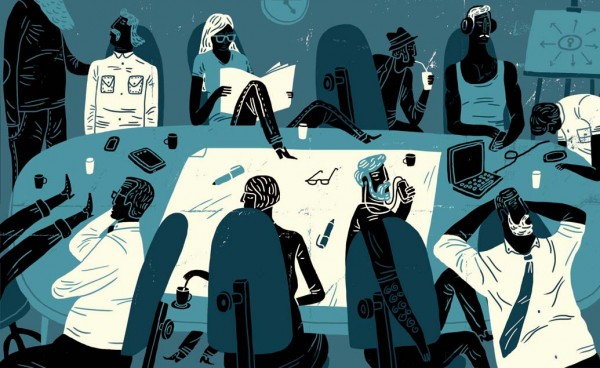Idea-generation is the linchpin of our work. So why are many of us terrible at it? Experts offer tips for improving your creative sessions. Illustration by Oivind Hovland
The team gathers in the conference room, white board at the ready, pumped to come up with some cool new ideas. Ten minutes into the session, the group’s strongest personality starts to dominate the conversation. Ideas get dissected, evaluated, kicked around, criticized. The quietest staffer shuts down. The creative director loses energy and relinquishes control over the meeting. An hour later, the team leaves the room deflated and unconfident in any of the concepts they shared.
Why do most brainstorm sessions resemble this scenario? Brainstorming is supposed to be one of the activities that we love most—and that our friends in non-creative professions envy most—about our jobs. We think of brainstorming as the wild-blue-yonder, out-of-the-box, free-flowing development of ideas—a literal turbulent storm of creativity. And this, according to the experts, is exactly the problem with most idea-generation sessions: They lack focus, structure, discipline. We’ll take a look at what typically goes wrong with brainstorming and learn ways to improve this essential element of our work.
Illustration by Oivind Hovland
The team gathers in the conference room, white board at the ready, pumped to come up with some cool new ideas. Ten minutes into the session, the group’s strongest personality starts to dominate the conversation. Ideas get dissected, evaluated, kicked around, criticized. The quietest staffer shuts down. The creative director loses energy and relinquishes control over the meeting. An hour later, the team leaves the room deflated and unconfident in any of the concepts they shared.
Why do most brainstorm sessions resemble this scenario? Brainstorming is supposed to be one of the activities that we love most—and that our friends in non-creative professions envy most—about our jobs. We think of brainstorming as the wild-blue-yonder, out-of-the-box, free-flowing development of ideas—a literal turbulent storm of creativity. And this, according to the experts, is exactly the problem with most idea-generation sessions: They lack focus, structure, discipline. We’ll take a look at what typically goes wrong with brainstorming and learn ways to improve this essential element of our work.

